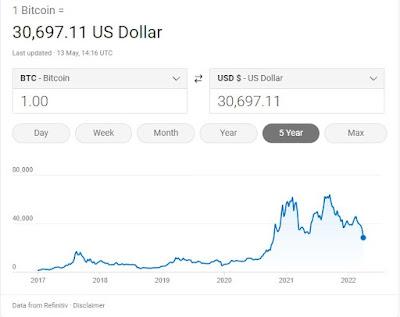In techincal analysis, which means recognising patterns in price charts - of quoted shares or commodities, one of the most powerful signals is the head and shoulders pattern.
These can form over several months to two years. Basically, the longer the pattern takes to form, the more reliable it is.
Here's Bitcoin over the last five years, from msn:

Purists might argue this looks slightly different to the classic pattern, i.e. the left shoulder is higher than the right shoulder. Or whether we should be using a logarithmic scale. Be that as it may, a one-and-a-half year time frame outweighs such minor niggles, and it looks like the tulip crypto bubble is finally bursting, as any sane person has expected all along.
HMRC had an outbreak of commonsense and updated their guidance on crypto-currencies. They decided that despite the name, crypto-currencies are not money or a currency, for the simple reason they are not backed by anything. I can't find the quote right now, it was something had to read up on at work. OK, apparently some issuers pretend they are a bank (how is that even legal?) and say that if you can't find a taker for your tokens, you can hand them back to the issuer for a fixed price. In real life, that's not asset-backed* as the issuer will have fittered away your money on something else, that's a Ponzi scheme (and how is that legal?).
* Despite what people say, a fiat currency is backed by something - you can use a country's currency to pay your tax liabilites in that country. People will always have to pay taxes, so there will always be demand for your country's currency.
Everybody in Country X could decide that their country's currency is a load of rubbish and decide to only use USD for savings and payments if they wished. Doesn't change anything, Country X tax office would work out your tax bill in X-dollars and send you a demand in X-dollars which you have to pay in X-dollars. You then have to change the USD you have in your bank account for X-dollars and hand it over to Bank of X. So Bank of X will always be able to issue (print) more X-dollars, knowing that sooner or later, people will have to 'buy' them (i.e. hand over hard currency USD).
